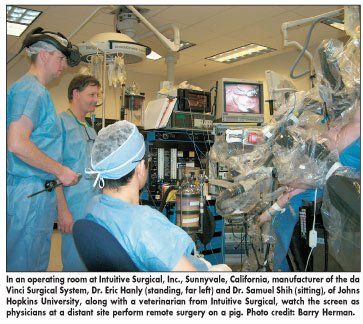Surgeons Perform Remote Robotic Animal Nephrectomy Over Public Internet: A First
Remote robotic nephrectomy performed over the public internet is an inexpensive form of tele-surgery that appears feasible, according to a proof-of-concept study presented at the 101st Annual Meeting of the American Urological Association (abstract 1075).
ATLANTARemote robotic nephrectomy performed over the public internet is an inexpensive form of tele-surgery that appears feasible, according to a proof-of-concept study presented at the 101st Annual Meeting of the American Urological Association (abstract 1075). Such surgery could "extend the reach of expert surgeons," said Col. Noah Schenkman, MD, Walter Reed Army Medical Center. The military would like to use such remote surgery in the field "to provide military surgeons with the ability to mentor and perform procedures from remote locations on soldiers wounded on the battlefield," he said.

Dr. Schenkman and his associates modified a da Vinci Surgical System to allow network communication between surgeon's consoles in Colorado and Ohio and the surgery site in California. The subjects were Californian swine. In the first attempt, the investigators had available 3.0 Mbps of bandwidth. Remote surgeons were limited by the high round-trip latency of 900 ms and poor image quality. Rather than performing the nephrectomies, the remote surgeons could only assist the on-site surgeons. They subsequently used an upgraded video CODEC and had available 8 Mbps. This reduced the round-trip delay to 450 ms, allowing the remote surgeons to perform two nephrectomies and two adrenalectomies. "The surgeon did have to compensate [for the delay], mostly by slowing down his movements," he said.
This study included several "firsts": the first US-based telesurgery, first telesurgery using a da Vinci system, first stereoscopic surgical video streaming, first collaborative telesurgery with multiple simultaneous operators, and first telesurgery using the public internet.
Newsletter
Stay up to date on recent advances in the multidisciplinary approach to cancer.
Elevating the Quality of Cancer Care via Cross-Department Collaboration
Experts from Sibley Memorial Hospital discuss how multidisciplinary work has enhanced outcomes such as survival and resource use at their institution.
Artificial Intelligence in Cancer Care: Addressing Challenges and Health Equity
Artificial intelligence may mitigate overdiagnosis and unnecessary treatments in cancer cancer care by integrating with precision medicine.